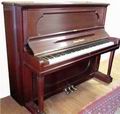
The simple one is probably the more common. We refer to one as the simple Art Deco style and the other as the complex Art Deco style. It may be of interest that we’ve worked on two versions of the Mason & Hamlin symetrigrand. And be sure that he uses the very best possible quality wire and bass strings. Just make sure that whoever rebuilds the piano knows what he (or she) is doing with regard to pinblock installation and drilling and with regard to plate installation. If anything, since they are Mason & Hamlins, I expect that they would be more stable. I sincerely doubt that these pianos are less stable than other baby grands. Tuning stability was perfectly fine in all of these pianos until they were sold and we have never had a report of a tuning problem from any of the people who bought them. Our experience with these pianos is that they compare very favorably with the 5’ 1” Steinway model S baby grand both with regard to the sound that they produce and to the quality of the touch. I doubt that any were built prior to the 1930’s – especially since they are all Art Deco. Each of these pianos was built between 19. I’m not sure how many we worked on before that, but certainly a few.

And, besides, I really like the way they look.Īccording to my records, during the past six years, we rebuilt and sold eight Mason & Hamlin symetrigrands. And, like all M&H pianos, they are rather massively built for its size. Yes, we updated the design a bit, but what a sweetheart of a piano! If I were considering a piano in that size range I'd snap one up in a heartbeat. We also recently remanufactured a M&H SG - the only one I've seen out here in the West. Nor did I find the bass strings to be appreciably longer than on any other piano of its size but the soundboard is rather more efficiently shaped. The trouble is - all other things are rarely equal! I expect in this case the tendency to go out of tune a bit more faster than normal is probably related either to its being recently rebuilt or some climate related factors. Can others contribute? All things being equal I can't see why a shorter piano should go out of tune any faster than a longer piano. I personally haven't seen any difference in tuning stability from others. Now the point of the Mason sg is to give longer bass strings in the same size box as another small grand. The shorter the strings, the sooner the piano will audibly go out of tune. It is true that the smaller the piano, the shorter the strings. I'm not a piano expert, but that fact was one of the things that tipped me toward the Petrof (which I love). I went back several times and played this little beauty, but I noticed that of all the ones I played week-to-week - this little symmetrical did NOT seem to hold its tune. Boyd, not that many were made, the symmetrical style just never caught on fire - apparently people have a particular "look" they want in a grand piano. I went back several times to look at the symmetrical. It was at Boyd's Piano in Fairfax, Virginia (which specializes in rebuilt pianos - nothing in the store but steinways, Mason & Hamlins, and an occasional Steif).

The case was beautiful, it had been entirely rebuilt. I also really liked the M&H sound, truly amazing for a grand that small. Ikaplatow, In my recent search for "my" piano, I had a difficult time deciding between a 5' Mason & Hamlin symmetrical grand (1904 I believe it was) and what I ended up buying which was a Petrof Chippendale IV (4 months old).


 0 kommentar(er)
0 kommentar(er)
